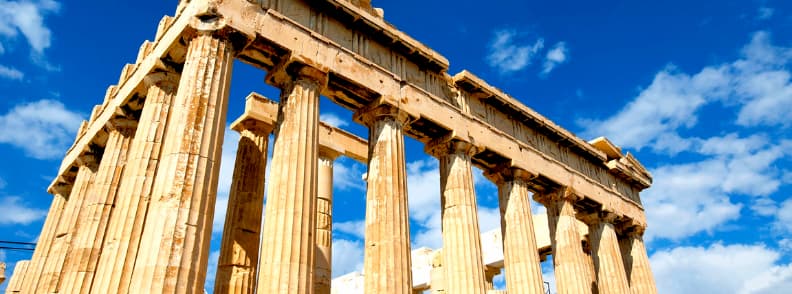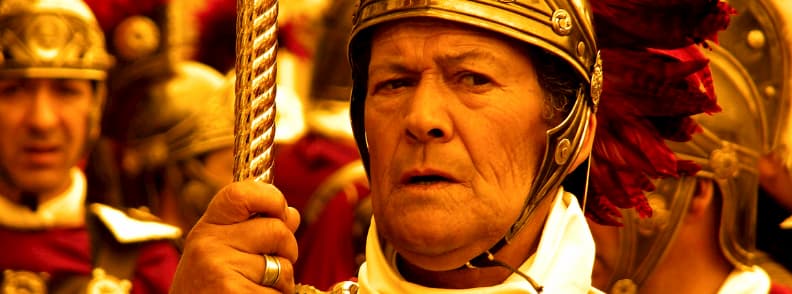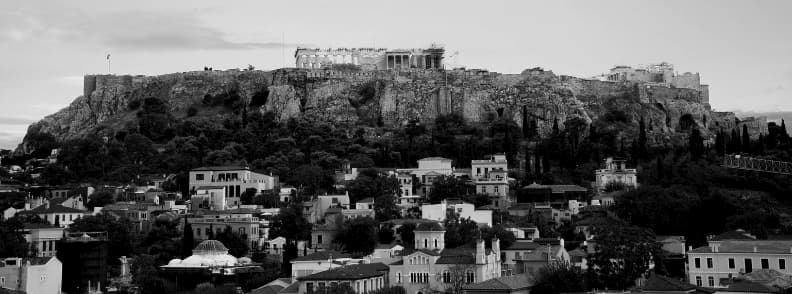Athens is one of the oldest continuously inhabited cities in the world, with a past that stretches back over 3,400 years. The history of Athens isn’t just a sequence of distant events, it’s something you walk through, feel beneath your feet, and catch glimpses of in side streets and café courtyards. Before you visit the Greek capital, learning a little about its origins and evolution helps you understand what you’re actually looking at and why it matters.
What is the history of Athens? It began with early Neolithic settlements clustered around the Acropolis and grew into the heart of one of the most influential civilizations in human history. The city gave birth to democracy, shaped Western philosophy, and became a cultural power during the golden age of Athens. Later, it endured conquest, decline, and occupation, before rising again as the modern capital of Greece.
History of Athens Timeline
If you’ve ever learned about Socrates, the Parthenon, or the trial of democracy in school, being here feels familiar in a strange way. You remember fragments from textbooks. Then you stand in the Ancient Agora, where actual political debates once shaped a city, and those fragments click into place. The Athens timeline is embedded in the Greek capital, reaching far and wide from history books.
This Athens travel guide follows that timeline from ancient Athens through Roman rule, the Byzantine and Ottoman periods, all the way to the rebirth of a modern European capital. You’ll get the Athens history timeline you might expect, but also something more grounded: local insights, a sense of place, and stories that make the ruins meaningful.
Quick Facts About Athens History
Athens has been inhabited for over 5,000 years, making it one of the world’s oldest cities still alive with daily life. Its long past unfolds in layers, from prehistoric villages to a sprawling capital that still bears traces of every era.
Here’s a quick look at how the history of Athens fits together:
| Period | Approx. Dates | What Happened |
|---|---|---|
| Neolithic Settlement | Before 3000 BCE | Early farming communities established on and around the Acropolis hill |
| Mycenaean Athens | 1600-1100 BCE | Fortified palace on the Acropolis Hill; part of wider Bronze Age trade networks |
| Founding Myths & Early Kings | 1100-800 BCE | Stories of Cecrops, Theseus, and the early shaping of Athenian identity |
| Aristocracy to Reforms | 800-500 BCE | Transition from monarchs to aristocrats; Solon and Cleisthenes introduced early democracy |
| Golden Age of Athens | 500-400 BCE | Political power under Pericles; flourishing of architecture, philosophy, and theatre |
| War and Decline | 400-300 BCE | Peloponnesian War, Athenian defeat, Macedonian control after 338 BCE |
| Roman and Byzantine Rule | 146 BCE-1456 CE | Cultural hub under Rome; then Christian city in the Byzantine Empire |
| Ottoman Period | 1456-1821 | Decline under Ottoman rule; Parthenon used as a mosque and an ammunition depot |
| Modern Rebirth | 1821-today | Independence from Ottoman rule; capital of Greece from 1834; now a thriving modern city |
Athens isn’t a city with ruins, it’s a city built through ruins. Myth and history, empire and resistance, all leave traces that still shape how the city feels when you walk through it. From Athenian democracy to the Ottoman occupation, every age left a visible mark.

I. Prehistoric & Mythical Athens (Before 800 BCE)
Before philosophers, temples, or democracy, Athens was already ancient. The city’s earliest chapters stretch back to the Neolithic age, long before it became a centre of classical civilization. To understand ancient Athens, you need to look at the land itself, how its hills shaped where people settled, and how mythology fused with topography to define the city’s early sense of self. The Acropolis was a natural fortress that became the heart of identity, myth, and memory. What we now call the Athens founding may be a matter of history, but it’s also a story the Athenians told themselves, and it shaped how they built their world.
The First Athenians, from Caves to Citadel
The Acropolis hill has been inhabited since at least 5000 BCE. Early Neolithic settlers built homes near its limestone slopes, drawn by access to fresh water from underground springs and the protection of high ground. Traces of these earliest Athenians (pottery fragments, foundations, burial sites) suggest continuous occupation through the Stone and Bronze Ages.
In these early layers of ancient Athens, there was no grand city-state, just communities clustering in a location that offered both defensibility and visibility. You can still find remnants of this early presence under and around the Acropolis Museum. The idea of Athens as eternal starts here, not in philosophy or architecture, but in the sheer fact that people never left this rock.
Mycenaean Era and the Rise of Bronze Age Athens
By around 1600 BCE, Athens had become part of the Mycenaean world, the same civilization that built palaces at Mycenae, Pylos, and Thebes. A Mycenaean palace once stood atop the Acropolis, fortified with Cyclopean walls. Athens was a regional power, but what’s most striking is that it survived the widespread collapse that hit other Mycenaean centers around 1200 BCE.
The Athenians later explained this survival through the myth of autochthony: the belief that they were born from the very soil of Attica, unlike other Greeks who came from elsewhere. The snake-bodied King Cecrops, part man and part serpent, was said to have been the city’s first king. This myth became a cornerstone of Athenian identity: Athenians were natives, not settlers, and therefore had a deeper claim to their land and traditions.
Visit Athens Tip: When walking through the Ancient Agora, pause at the signs that show where Mycenaean graves were found. It’s easy to overlook how deep the layers go, but some of those stones are older than the myths themselves.
Founding Myths: Athena vs Poseidon, Theseus and the Polis
The city’s most iconic myth, the contest between Athena and Poseidon, is as much about place as it is about power. According to legend, the gods competed for the right to become the patron of Athens. Poseidon struck the rock with his trident, producing salt water (or a horse, depending on the version), while Athena offered the olive tree, a gift of peace and prosperity. The Athenians chose her, and the city took her name.
This tale wasn’t just symbolic. It was tied to real geography: you can still see the sacred olive tree in the Erechtheion on the Acropolis, next to what was believed to be the mark of Poseidon’s trident.
Another crucial myth is that of Theseus, the slayer of the Minotaur and the unifier of Attica. Beyond heroism, his story reflects the consolidation of smaller villages into a single polis or city-state. The myth explains and justifies Athens’ growing power over the surrounding region.
These myths are embedded in the stones of Athens, marking temples, rituals, and boundaries. Knowing them gives meaning to what you see, even if you’re not a believer.
II. From Monarchy to Democracy (800-500 BCE)
The roots of Athenian democracy didn’t appear overnight. They grew slowly from older systems of kingship and aristocracy, shaped by power struggles and social tension. Before Athenian democracy emerged, Athens was ruled by a small elite. Political participation was limited, laws were unwritten, and inequality ran deep. The shift toward broader civic involvement was driven by reformers like Solon and Cleisthenes, who laid the legal and institutional groundwork for what became the first true democracy in history. Their legacy still echoes in modern political thought, and, in Athens, in the very layout of ancient spaces like the Agora and the Pnyx.
The Archons and the Areopagus: Rise of Aristocracy
After the mythical kings faded from power, Athens moved into an age of aristocratic rule. From around the 8th century BCE, archons (ruling magistrates) were chosen from the noble class. These men held office in rotation, and most political power rested with the Areopagus, a council made up of former archons who governed by tradition and class interest.
This system worked… for the elite. Everyone else had little say. Farmers were falling into debt slavery, land was concentrated in fewer hands, and widespread unrest simmered just beneath the surface. Calls for reform became louder, not from idealism, but from the sheer pressure of social breakdown.
Solon’s Reforms (594 BCE), a Legal Turning Point
Faced with the risk of civil war, the Athenians turned to Solon, a respected noble with a reputation for fairness. He wasn’t a radical, but he introduced reforms that would reshape Athens. The most famous of these was seisachtheia, the “shaking off of burdens”, which abolished debt slavery and erased many personal debts.
Solon also divided citizens into income classes, shifting power away from hereditary privilege. He created the boule, a council of 400 citizens, and established heliaia, a popular court open to non-nobles. These changes didn’t create democracy in full, but they opened the door to participation.
As someone who studied Political Science, I found the layout of the Ancient Agora striking. The foundations of buildings like the Stoa of Zeus and the old bouleuterion may be in ruin, but they are the physical outlines of political invention.
Solon’s system still favored the rich, and unrest returned within decades. But for the first time, Athens had written laws, income-based representation, and legal institutions with public oversight.
Cleisthenes and the Democratic Machine (508 BCE)
After years of instability and tyrants like Peisistratos and his sons, the final push toward Athenian democracy came from Cleisthenes, a reformer from the Alcmaeonid family. He introduced changes that were structural and profound.
He reorganized the population into ten new tribes, each mixing citizens from the city, countryside, and coast, breaking old regional loyalties. He expanded the boule to 500 men, with 50 chosen from each tribe, and made ostracism a tool to exile would-be tyrants by popular vote.
Importantly, Cleisthenes granted political rights based on citizenship rather than birthright or wealth. All male citizens could now participate in the ekklesia (Assembly), propose laws, and vote on them. This was unprecedented.
When did Athens become a democracy? Most historians agree that 508 BCE marks the start, not of a perfect system, but of a political experiment unlike anything the world had seen.
The reforms of Solon and Cleisthenes are why we talk about “Athens” in political theory. And when you stand where the Assembly once met, the idea that government could belong to ordinary people feels less like a modern invention and more like something ancient and earned.

III. The Golden Age of Athens (500-400 BCE)
This was the moment Athens became an idea, a model of power, beauty, thought, and culture that still shapes how we think about civilization itself. Following its role in the Persian Wars, Athens led the formation of the Delian League, a defensive alliance that gradually turned into an empire. With tribute flowing in from across the Aegean, the city expanded its fleet, rebuilt its walls, and began an ambitious building program under the leadership of Pericles.
This was the Golden Age of Athens, when democratic institutions matured, monumental art flourished, and philosophy found fertile ground in public spaces. You can still feel that legacy, especially standing on the Acropolis, where the wind and stone seem to remember.
The Age of Pericles
Pericles led Athens from 461 to 429 BCE, during its height as a political and cultural force. Though elected as strategos (general) year after year, he was far more than a military leader. He expanded citizen access to political offices, introduced state pay for jurors and council members, and oversaw the transformation of Athens into a monumental city.
His building program, funded largely through the Delian League, was bold and unapologetically political. It was about showing Athens as the rightful leader of Greece. But he also invested in the people, making citizenship something more inclusive and offering state support for public festivals, theater, and debate.
Standing on the Acropolis today, beyond columns and ruins, you’re looking out over the same view Pericles would have seen. I still found myself wondering who else had stood in that same spot, thinking about the future.
Building the Acropolis, a Monument of Power
Pericles’s building campaign transformed the Acropolis into the heart of Athenian identity. The Parthenon, designed by Iktinos and Kallikrates and sculpted by Phidias, was completed between 447 and 432 BCE. It honored Athena and showcased Athenian craftsmanship and dominance.
Nearby, the Erechtheion (with its Caryatids) marked sacred ground tied to the city’s mythic past: the olive tree of Athena and the trident mark of Poseidon, which we discussed above. The Propylaea, the monumental gateway, framed the approach. These weren’t isolated buildings. Together, they formed a carefully designed visual statement: Athens rules not just through might, but through culture.
When was the Parthenon built? Between 447 and 432 BCE, during the leadership of Pericles, using tribute from the Delian League.
The Acropolis was deliberately symbolic, layered with myth, memory, and power. Knowing what each building represented adds weight to your visit.
Intellectual Athens: Socrates, Plato, and Aristotle
While politics and empire played out on the Acropolis and in the Assembly, Athens became the center of intellectual life in the Greek world. Socrates walked the streets of the Agora, challenging fellow citizens with pointed questions about virtue and justice. He left no writings, but his student Plato founded the Academy around 385 BCE. It was the first institution of higher learning in the West.
Plato’s student Aristotle later founded the Lyceum, where he taught logic, biology, and politics. These weren’t distant thinkers in ivory towers. Their work happened in public places, tied to the rhythm of the city.
Who were the philosophers of ancient Athens? Socrates, Plato, and Aristotle were the most influential, each shaping Western thought across ethics, politics, and science.
Many of their original teaching grounds, especially the Agora and the Lyceum, are places you can still walk through today. The spaces feel humble, but they sparked ideas that changed how humans understand truth, power, and each other.
IV. Athens in Decline: War, Conquest & Adaptation (400 BCE-500 CE)
The fall of Athens didn’t happen in a single moment. It happened in waves. Power shifted, empires rose, and Athens found itself repeatedly adapting to survive. After its peak in the 5th century BCE, a long period of political decline began, marked by civil strife, war with Sparta, foreign domination, and the eventual absorption into the Roman Empire.
Still, the city never became irrelevant. Even when its military power faded, its cultural and intellectual legacy remained strong. From the Peloponnesian War to the Roman occupation of Athens, the city evolved as a symbol of what Greek civilization meant.
The Peloponnesian War (431-404 BCE)
Tensions between Athens and Sparta had been rising for decades, but war finally broke out in 431 BCE. What followed was a generation-long conflict that devastated both sides. Athens suffered from internal division, military overreach, and a catastrophic plague that killed up to a third of its population, including Pericles himself.
The war dragged on until 404 BCE, when Athens surrendered. Its empire dissolved, democracy was briefly overthrown, and Sparta installed a puppet regime. Though democracy returned within a year, Athens was never again the dominant power in Greece.
What caused the fall of Athens? The Peloponnesian War weakened Athens through military defeat, disease, political instability, and economic collapse, ending its status as a major power.
But the fall was only political. Culturally, Athens remained influential. Its schools continued. Its plays were still performed. Its thinkers were still quoted across the Greek world.
Macedonian and Hellenistic Period
In 338 BCE, at the Battle of Chaeronea, King Philip II of Macedon defeated the combined forces of Athens and Thebes. Athens lost its independence again, this time to a rising northern power. Still, Philip allowed it to retain some autonomy, likely out of respect for its cultural status.
After Philip’s assassination, Alexander the Great took over. Though born in Macedon, he had been educated by Aristotle and admired Athens. The city benefited from his patronage and the new networks of the Hellenistic world, even if it no longer made political decisions.
This was the beginning of Athens as a symbolic capital, no longer commanding armies, but shaping minds.

Roman Athens, the Learning Capital of the Empire
By 146 BCE, Athens was part of the Roman world. It had no military power left, but its reputation for wisdom and culture attracted Roman students, senators, and emperors.
Cicero studied there. Hadrian, one of Rome’s most cultured emperors, adored Athens. He funded public works, including the Library of Hadrian, and completed the long-unfinished Temple of Olympian Zeus. The Romans also built the Roman Agora, a new marketplace that complemented (but did not replace) the classical Greek one.
What did the Romans do for Athens? They preserved its cultural prestige, added new public buildings, and supported education, keeping Athens alive as the intellectual heart of the empire.
This era saw Athens at its most paradoxical: politically diminished, but spiritually and intellectually exalted. Philosophical schools flourished. Monuments from different ages coexisted. And even as the world changed, people still looked to Athens as the cradle of thought.
From this point on, Athens would never again lead armies or forge empires, but it had become something just as lasting: a city that ruled through memory, intellect, and art.
V. Medieval & Ottoman Athens (500-1821 CE)
By the time the Western Roman Empire fell, Athens was already in transformation. No longer a centre of politics or power, the city entered a long stretch of quiet survival. Under Byzantine rule, Athens became a Christian stronghold. Later, it passed through Crusader hands and into the grip of the Ottoman Empire. During this entire period, it was never a major capital, but it was never abandoned, either.
What defines this part of Athens history timeline is its ability to absorb change. Churches rose where temples once stood. Mosques rose where Athens churches had been. The Parthenon alone served as a temple, a church, a mosque, and then a ruin, all without ever being completely erased. You can still feel that layering today, in how the city looks and feels.
From Pagan to Christian: The Byzantine Transition
After Athens became part of the Byzantine Empire in the late 4th century CE, Christianity gradually replaced the old religions. Pagan philosophical schools lost imperial support. The Academy of Plato and Lyceum of Aristotle were closed by imperial decree in 529 CE.
Temples were either repurposed or dismantled. The Parthenon became a church dedicated to the Virgin Mary. The Erechtheion, once sacred to multiple deities, was used as a Christian basilica. As the empire Christianized, the city’s intellectual life faded. Athens was no longer a beacon of learning. It was a provincial town within a much larger religious empire.
Many of the Christian frescoes painted inside ancient temples were later removed, but the scars remain. They’re part of the visual history still visible today.
Latin Occupation and Crusader Rule
In 1204, the Fourth Crusade sacked Constantinople, and Athens fell under the control of Western knights. It became the Duchy of Athens, ruled by French and later Italian nobles. Latin Christianity replaced Orthodox tradition, and new architectural styles were layered over the old.
This period fractured the city’s cultural coherence. Power changed hands frequently, and no single authority invested deeply in restoration or preservation. Still, the Acropolis remained the symbolic centre, now holding a cathedral instead of a temple.
Athens wasn’t destroyed, but it was redirected. Its identity shifted again, and like always, it adapted without losing its historical gravity.
Ottoman Rule, from Mosque to Munitions
In 1456, the Ottomans captured Athens. The city was already in decline, but under Ottoman control, it faded further into provincial obscurity. The Parthenon became a mosque, complete with a minaret. Ancient buildings were quarried for stone. Roads were built right through ruins.
But the most devastating moment came in 1687, during the Venetian siege. The Parthenon, used by the Ottomans as a gunpowder magazine, was struck by artillery fire. The explosion blew apart the roof and much of the inner structure, turning one of the world’s most admired temples into a shattered ruin.
How was the Parthenon damaged? In 1687, a Venetian cannonball struck the Parthenon while it was being used by the Ottomans to store gunpowder, causing a massive explosion that destroyed much of the structure.
In the decades that followed, further losses came. In the early 19th century, Lord Elgin removed many of the surviving sculptures, including entire friezes and metopes, which were later sold to the British Museum.
Even today, you can feel the weight of that loss. The Parthenon doesn’t feel like a complete ruin. It feels like a building that was wounded, violently and deliberately. The layers of destruction are physical.
And yet, even through all this (religious conversion, war, looting), Athens held on to its identity. When independence finally came, it was ready to rise again.

VI. Rebirth of a Nation: Modern Athens (1821-Today)
The modern history of Athens began in war and was rebuilt in ambition. After centuries under foreign rule, the Greek War of Independence reshaped Athens’ destiny. Though barely more than a village by the early 1800s, the city was selected as the symbolic heart of a new Greek state, a city with ruins instead of palaces, but with history no other place could rival.
Today, Athens is the capital of Greece, a place where bougainvillea spills across neoclassical balconies and train lines rumble past ancient ruins. It has hosted the Olympics twice, expanded into a sprawling urban tangle, and still carries the imprint of every era that came before.
Independence and Restoration (1821-1834)
The Greek War of Independence, launched in 1821, brought Athens back into national history, but not without violence. The Acropolis changed hands multiple times, suffering damage from artillery and looting during sieges between Greek revolutionaries and Ottoman forces.
When the war ended and Greece was recognized as independent, Athens was a ruin-strewn hilltop town with a population of around 5,000. Still, in 1834, it was declared the capital of the modern Greek state. The decision was symbolic: no city represented Greek identity, history, and ambition quite like Athens.
Romantic-era Europeans, from poets to archaeologists, flocked to Athens, seeing in its broken stones a vision of what Greece once was and what it could be again.
A City Reimagined: 19th-20th Century Growth
In the decades that followed, Athens was rebuilt almost from scratch. With support from Bavarian architects under King Otto, the new capital gained the University of Athens, the National Library, and the National Archaeological Museum, institutions that signaled a return to intellectual and civic pride.
After the Asia Minor Catastrophe in 1922, tens of thousands of Greek refugees from Turkey settled in and around the capital, nearly doubling its population. This wave of migration reshaped neighborhoods like Kaisariani, Nea Ionia, and Nea Smyrni, layering the city with new dialects, cuisines, and musical traditions.
The 20th century brought political turmoil and rapid modernization. Yet Athens kept hold of its bones (the temples, the colonnades, the underground chambers) even as cars, trams, and concrete rose around them.
World War I and the Metaxas Regime
During World War I, Athens was caught in the National Schism between royalists (supporting King Constantine I) and republicans (led by Eleftherios Venizelos). Political instability shook the city as foreign troops occupied parts of it, and famine hit hard.
In 1936, General Ioannis Metaxas came to power and ruled as a dictator. Though he introduced some public works and industrial expansion, his regime was marked by censorship, propaganda, and authoritarian control. Civil liberties in Athens were tightly restricted.

Nazi Occupation and the Civil War
In 1941, Nazi forces entered Athens. For three years, the city lived under occupation. The Great Famine of 1941-42 killed thousands. The Jewish community, once thriving, was deported and nearly destroyed.
Resistance movements grew in and around the city, and by the time the Germans withdrew in 1944, civil war loomed. The Dekemvriana clashes in central Athens between communist partisans and British-backed government forces turned the capital into a battlefield.
These events weren’t just about geopolitics. They played out in familiar squares in Athens and under ancient shadows. Monastiraki, Syntagma, and the National Garden, they all witnessed violence rooted in the struggle for post-war power.

Reconstruction and the Junta (1949-1974)
Postwar Athens expanded fast. Mass migration from the countryside filled the city, and apartment blocks (polykatoikies) replaced older homes. Traffic, smog, and urban sprawl became part of Athenian life.
But in 1967, democracy collapsed again. The military junta, led by Georgios Papadopoulos, seized power and ruled with censorship, torture, and repression. In 1973, students at the Athens Polytechnic staged a peaceful uprising. The army responded with tanks. Dozens were killed.
The Polytechnic uprising is now a symbol of resistance, honored every November with protests and flowers left at the school gate. That gate, still bent and scarred, is a reminder that democracy in Athens wasn’t only ancient. It had to be re-won.

Athens in the 21st Century
Hosting the 2004 Summer Olympics was a pivotal moment. The city gained a modern metro system, new highways, the Athens Tram, and an expanded airport. Ancient sites were cleaned, lit, and connected by pedestrian paths. For a while, it looked like Athens had found the perfect balance between past and present.
Then came the economic crisis. From 2010 onward, Athens struggled with austerity, protests, unemployment, and recession. Buildings sat abandoned. Graffiti flourished. Tourism dropped… then surged again.
Even now, walking through neighborhoods like Psyrri or Makrygianni, I find ruins beneath cafés and courtyards. You sip coffee on glass floors that reveal Roman baths. You wait for a tram beside Byzantine foundations. The past isn’t separate, it’s still breathing under the streets.
Modern Athens is not a perfect city, but it’s a real one. It never hides its scars, and that makes it more compelling. Every ruin still in place (and every person sipping coffee beside one) is part of its living story.
Athens History Timeline: Key Eras and Events
If you want a clear view of the city’s long and layered past, this is the place to start. This streamlined Athens history timeline offers a chronological overview of the most important turning points, from prehistoric settlement to modern rebirth. It’s ideal for travelers, students, and anyone curious about how Athens grew from myth to metropolis.
Whether you’re scanning for a quick reference or mapping a walking route in Athens through the city’s ruins, this list gives you the Athens timeline in digestible form, helping you answer What are the most important dates in Athenian history?
Athens History Timeline: Key Eras and Events
| Date | Period | Key Event |
|---|---|---|
| c. 5000 BCE | Neolithic Era | Pottery workshops are active in Kerameikos area |
| c. 3200 BCE | Late Neolithic | Continuous habitation begins |
| c. 1600 BCE | Mycenaean Period | Fortified palace established on the Acropolis |
| c. 1400 BCE | Mycenaean Period | Grave sites in the Agora indicate elite presence |
| c. 1200 BCE | Bronze Age Collapse | Mycenaean world falls; Athens survives |
| c. 1100 BCE | Early Iron Age | First human settlement on the Acropolis slopes |
| c. 1050 BCE | Mythical Athens | Rise of Theseus myths; unification of Attica |
| c. 950 BCE | Iron Age Recovery | Monumental graves appear in the Dipylon cemetery |
| c. 850 BCE | Geometric Period | Monumental graves appear in Dipylon cemetery |
| 776 BCE | Archaic Period | First Olympic Games held in Olympia; Athenians later participate |
| c. 750 BCE | Archaic Period | Foundation of Homeric tradition; myth of Cecrops takes root |
| c. 700 BCE | Archaic Period | Rise of Eupatridae aristocracy in Athens |
| 683 BCE | Archaic Period | Annual archonship established, ending life-term magistrates |
| 621 BCE | Archaic Period | Draco’s law code was introduced (written laws, harsh penalties) |
| 594 BCE | Archaic Period | Solon’s reforms: debt relief, boule, heliaia |
| 561 BCE | Archaic Period | Peisistratos seizes power; the era of tyrants begins |
| 527 BCE | Archaic Period | Death of Peisistratos; rule passes to his sons |
| 514 BCE | Archaic Period | Assassination of Hipparchus; Harmodius and Aristogeiton celebrated |
| 510 BCE | Archaic Period | Overthrow of tyranny; end of Peisistratid rule |
| 508 BCE | Early Classical | Cleisthenes’ democratic reforms reorganize political structure |
| 490 BCE | Classical Period | Battle of Marathon: Athens defeats Persia |
| 483 BCE | Classical Period | Discovery of silver at Laurion; naval fleet expanded |
| 480 BCE | Classical Period | Battle of Salamis: naval victory under Themistocles |
| 479 BCE | Classical Period | Battle of Plataea ends Persian invasions |
| 478 BCE | Classical Period | Delian League founded under Athenian leadership |
| 461 BCE | Classical Period | Pericles begins leadership; Age of Pericles begins |
| 447-432 BCE | Classical Period | Parthenon constructed on Acropolis |
| 431-404 BCE | Classical Period | Peloponnesian War with Sparta leads to Athens’ defeat |
| 403 BCE | Classical Period | Democracy restored after Thirty Tyrants |
| 399 BCE | Classical Period | Socrates executed for impiety and the corruption of youth |
| 387 BCE | Classical Period | Plato founds the Academy |
| 338 BCE | Hellenistic Period | Battle of Chaeronea: Macedon conquers Greece |
| 335 BCE | Hellenistic Period | Aristotle opens the Lyceum in Athens |
| 307 BCE | Hellenistic Period | Democracy briefly restored by Demetrius Poliorcetes |
| 146 BCE | Roman Period | Athens falls under Roman control |
| 86 BCE | Roman Period | Sulla sacks Athens; major destruction |
| 51 BCE | Roman Period | Cicero visits Athens as part of his philosophical training |
| 117 CE | Roman Period | Hadrian builds the Library and completes Temple of Olympian Zeus |
| 267 CE | Late Roman Period | Herulians sack Athens; walls rebuilt |
| 529 CE | Byzantine Period | Closure of Academy by Justinian marks end of classical schools |
| 1205 CE | Crusader Rule | Athens becomes Duchy of Athens under Latin control |
| 1311 CE | Crusader Rule | Catalans take over Duchy of Athens |
| 1456 CE | Ottoman Period | Ottomans capture Athens; Parthenon becomes a mosque |
| 1687 CE | Ottoman Period | Parthenon explosion during Venetian siege |
| 1801 CE | Ottoman Period | Elgin Marbles removed and shipped to Britain |
| 1821 CE | Greek War of Independence | Athens joins uprising; Acropolis besieged |
| 1834 CE | Modern Period | Athens declared capital of modern Greece |
| 1896 CE | Modern Period | Athens hosts the first modern Olympic Games |
| 1941-1944 CE | World War II | Nazi occupation of Athens; famine and resistance |
| 1973 CE | Military Dictatorship | Athens Polytechnic Uprising challenges junta |
| 2004 CE | 21st Century | Athens hosts the Olympics again; metro and tram systems completed |
Use this Athens history timeline as a reference when visiting sites, planning your trip, or writing your own notes. This Athens timeline helps make sense of the layers you’ll walk through in the city, from Neolithic stone to neoclassical marble, with every chapter leaving its trace.

Exploring Athens Historical Sites Today
You don’t need to read a history book to experience the history of Athens, you just need to walk through it. Unlike many European cities where monuments are tucked behind ropes and glass, Athens historical sites are woven directly into everyday life. Temples and ruins sit beside cafés and tram lines. Statues face you on street corners. Below your feet, under plexiglass, are walls that stood before Christ.
This section of your Athens travel guide takes you through the most important ancient landmarks, and a few quieter places where history lingers without the crowds. If you plan to visit Athens, knowing what you’re looking at will make all the difference.
The Acropolis Then and Now
No matter how many photos you’ve seen, the Acropolis still stops you. Following the winding footpath up from Dionysiou Areopagitou Street, layers of history unfold as you pass the Theatre of Dionysus, the Odeon of Herodes Atticus, and the foundations of old city walls.
At the top, the Parthenon, the Erechtheion, and the Propylaea greet you in their fragmented grandeur. Wind rushes between columns. Fragments of sculpture still hint at divine scenes. Tour groups pass quickly, but it’s worth pausing, just to stare out over the city.
It’s impossible not to imagine who else stood here 2,000 years ago: generals, priests, slaves, philosophers. And then you realize: this exact view hasn’t changed that much.
Just opposite the hill, the Acropolis Museum brings ancient objects into daylight. Its glass floors reveal excavations beneath. Inside, friezes, tools, and statues from the site are arranged by context, giving a fuller picture of how Athenians lived, not just what they built.
Athens historical sites begin here… but they don’t end here.
The Ancient Agora, Walking Where Democracy Was Born
Where was democracy born? Right here, in the Ancient Agora. This was the city’s main civic and commercial space: part Athenian marketplace, part courthouse, part social square.
You can still walk its stone paths. To your right is the Temple of Hephaestus, better preserved than the Parthenon, with full columns and friezes intact. Straight ahead is the Stoa of Attalos, reconstructed in the 1950s and now home to a small but excellent museum.
The Agora was where citizens met, debated, voted, served on juries, and gossiped. It wasn’t elegant. It was messy and loud and political. It’s the birthplace of Athenian democracy. The idea of citizenship, accountability, and popular rule was tested in real time, right on these flagstones.
Don’t rush through it. Read the signs, look for inscriptions, and picture the debates.
Lesser-Known Historical Spots You Shouldn’t Miss
Not all ancient Athens is on a postcard. Some of the most atmospheric places are the ones without crowds:
- The Pnyx, where the Athenian Assembly met. A flat rock carved with steps and a speaker’s platform. Stand there and imagine 6,000 citizens gathered to vote. No ticket line, no fencing.
- Kerameikos, the ancient cemetery just outside the city gates. Sculpted gravestones, quiet paths, and the remains of the Sacred Way.
- Temple of Olympian Zeus, once the largest in Greece, now only a few columns stand, but the scale is still awe-inspiring.
These spots give you space to think. They’re not as photographed, but they’re just as important. And they’re often better for a slow, reflective visit.
Athens Museums That Bring the Past Alive
Athens museums are alive with context.
- The Acropolis Museum is the most famous, built to showcase artifacts from the hill itself. It’s modern, sleek, and open, with direct sightlines back to where each piece came from.
- The National Archaeological Museum holds treasures from across the Greek world: Mycenaean masks, Cycladic figurines, and Hellenistic sculptures. It’s dense and immersive.
Many museums in Athens are built right on top of ancient remains. You’ll find glass walkways over pottery kilns, mosaic floors revealed under staircases, and even exhibitions in metro stations (Syntagma, Monastiraki).
In Athens, history is built in, paved over, and re-exposed. And it rewards anyone who slows down enough to notice.
Frequently Asked Questions About Athens History
Curious travelers often ask the same questions when planning to visit Athens. Whether you’re standing on the Acropolis or wandering through the Agora, these common queries help frame what you’re seeing. This section answers the most frequent questions using clear, concise language, ideal for quick reference.
What is the history of Athens in short?
Athens is one of the oldest cities in the world, inhabited continuously for over 5,000 years. It began as a Neolithic settlement, grew into a Mycenaean stronghold, flourished in the Classical era, declined under Roman and Ottoman rule, and reemerged as the modern capital of Greece in 1834. Its history spans myth, empire, war, and democracy.
When was Athens founded?
Athens was first settled around 5000 BCE, during the Neolithic period. By 1600 BCE, it had become a Mycenaean center. Mythologically, the city was founded by King Cecrops, and its name comes from the goddess Athena, who won a divine contest to become its patron.
Where was democracy born?
Athenian democracy was born in the Ancient Agora, the civic heart of the city. Reforms by Cleisthenes in 508 BCE created the first system of direct citizen participation, with laws debated and voted on by male citizens. It was an early model of democratic governance.
When did Athens become a democracy?
Athens transitioned to democracy around 508 BCE, after reforms by Cleisthenes. This included tribal reorganization, citizen assemblies, and new voting systems. While not democratic by today’s standards (women, slaves, and foreigners were excluded), it was revolutionary for its time.
What was the Golden Age of Athens?
The Golden Age of Athens refers to the 5th century BCE, especially during the leadership of Pericles (c. 461-429 BCE). This period saw the construction of the Parthenon, the flourishing of theatre and philosophy, and the consolidation of democracy and imperial power through the Delian League.
How was the Parthenon damaged?
In 1687, during a Venetian siege, the Ottomans were using the Parthenon as a gunpowder storage site. A cannonball struck it, causing a massive explosion that destroyed the roof and much of the inner structure. This was the single most destructive event in its long history.
What did the Romans do for Athens?
The Romans preserved and enhanced Athens as a center of learning and culture. Emperors like Hadrian built the Library of Hadrian, the Roman Agora, and completed the Temple of Olympian Zeus. Roman Athens remained a hub for philosophical training, attracting students from across the empire.
Who were the most famous philosophers of Athens?
Socrates, Plato, and Aristotle are the most renowned. Socrates questioned Athenian norms in the Agora, Plato founded the Academy, and Aristotle taught at the Lyceum. Their teachings formed the foundation of Western philosophy and science.
When did Athens become the capital of Greece?
Athens became the capital of modern Greece in 1834, after the country gained independence from the Ottoman Empire. Though it was then a small town, its symbolic importance and ancient legacy made it the natural choice.
What are the most important historical sites in Athens?
The Acropolis (home to the Parthenon), the Ancient Agora, the Temple of Olympian Zeus, the Pnyx, and the Kerameikos cemetery are among the top historical sites. These locations span the city’s timeline from ancient myth to imperial rule.
How old is the city of Athens?
Athens is over 5,000 years old, with archaeological evidence of continuous settlement since the Neolithic era. Its age, combined with its role in shaping philosophy, politics, and art, makes it one of the most historically significant cities in the world.
These are just a few of the questions that come up again and again from curious travelers. Whether you’re standing in the middle of the Acropolis or planning your trip from home, knowing the answers adds depth to every step you take in Athens.
Why Athens’s Past Still Shapes Its Present
Athens has never been just one thing. It’s been a Mycenaean citadel, a city of gods and philosophers, a battlefield, a forgotten outpost, a capital reborn. Each layer added something (a system, a ruin, a word, a scar) that still shapes how the city feels and functions today.
What defines Athens more than any one monument is its resilience. It didn’t just survive conquest, collapse, occupation, or dictatorship. It kept going. It reused temples as churches, churches as mosques, and ruins as foundations. It reinvented democracy when needed, sometimes literally.
The legacy of Athenian democracy, classical architecture, philosophy, and urban design still echoes through the world. But in Athens, that legacy is physical. You walk past it. You eat next to it. You take the metro under it. The Acropolis still watches over everything, not as a nostalgic backdrop, but as a reminder of what the city built, lost, and reclaimed.
Knowing this full, complex timeline beyond the myths and dates changes how you experience the city. The stones become stories. The ruins feel alive. And the present starts to feel deeper than it did before.

